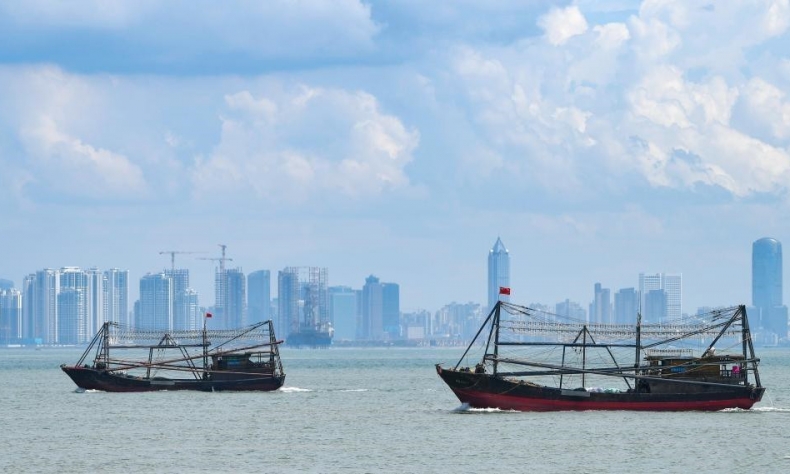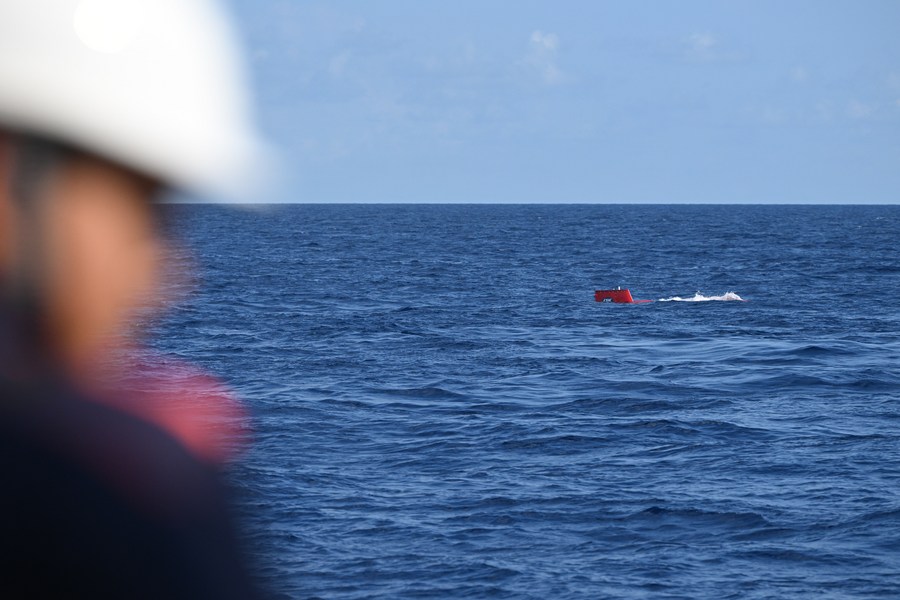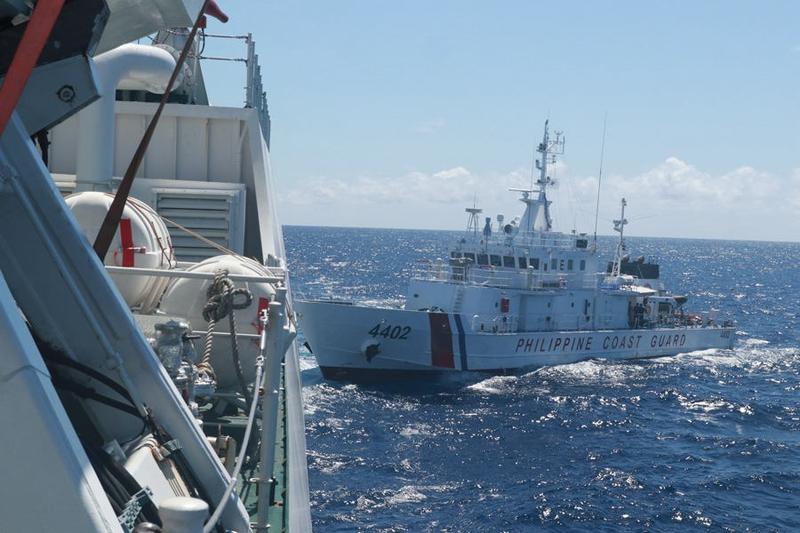The Situation in the South China Sea Has Further Intensified

The Philippines, backed by external forces, has been going back on its words and making provocations. This is the real cause of the current tensions at sea.
Two Philippine Coast Guard ships and two supply boats intruded into waters adjacent to the Ren’ai Jiao, or the Ren’ai Reef, to send construction materials to the military vessel illegally grounded there for its “repair and reinforcement” on March 23. The China Coast Guard (CCG) took necessary measures at sea to safeguard China’s rights, blocking the Philippine vessels.
CCG spokesperson Gan Yu stated that on March 23, only 18 days after the previous “resupply,” these “supply missions” were intended to cause trouble and provoke disputes, deliberately disrupting the peace and stability of the South China Sea.
“The Philippines needs to immediately stop violating China’s sovereignty and its provocations, and return to observing the spirit of the Declaration on the Conduct of Parties in the South China Sea (DOC). China will not waver in its resolve to safeguard its territorial sovereignty and maritime rights and interests,” Chinese Foreign Ministry spokesperson Wang Wenbin said on April 1.
According to Anthony Carty, an emeritus professor at the Beijing Institute of Technology School of Law and a visiting researcher at Peking University, the essence of the case for ownership of the Nansha Islands has been which country has the closest connection physically to the islands.
“It is accepted that Chinese fishermen have regularly used these islands as their home. Fishermen coming from Guangdong and Hainan provinces are there for up to six months a year, using the islands as a base for fishing,” he told Beijing Review. “And on that basis, the argument can be made that sovereignty of China follows its citizens.” This was affirmed by the UK Foreign Office Legal Department, following an exhaustive trawl of its historical archive since the 19th century. This opinion was adopted by the UK Cabinet Defense and Overseas Committee and entered in its records.
Sovereignty of South China Sea
China’s Nanhai Zhudao (the South China Sea Islands) consist of Dongsha Qundao (the Dongsha Islands), Xisha Qundao (the Xisha Islands), Zhongsha Qundao (the Zhongsha Islands) and Nansha Qundao (the Nansha Islands). They include, among others, islands, reefs, shoals and cays of various numbers and sizes, constituting inseparable parts of China’s territory. Ren’ai Jiao is situated within the Nansha Islands. The activities of the Chinese people in the South China Sea date back to over 2,000 years ago.
Professor Carty spent almost a decade examining national archives from France, Britain, and the United States dating back to the late 19th century to clarify the issue of sovereignty over the South China Sea.
“It’s basically a problem arising out of imperial European and American interventions in the region during the time when China was weakened and divided,” he said.
He pointed out that China’s sovereignty over the South China Sea Islands had never been disputed before the 20th century. But in 1933, France invaded some islands and reefs of the Nansha Islands, leading to the Incident of the Nine Islets.
Carty highlighted the discrepancy between the contemporary narrative regarding the Philippines’ sovereignty claims in the South China Sea and the historical records from British, French and American archives. According to these archives, there is unanimous agreement that the Philippines had no legitimate claim to sovereignty over any islands in the South China Sea.

He insisted that the British and French authorities need to acknowledge this contradiction between historical records and contemporary narratives, especially since they claim their own contemporary stance to be neutral on the issue of ownership.
In the late 1940s, the United States decided it was not in its interest for China to reclaim the South China Sea Islands. The San Francisco Conference in 1951 confirmed Japan’s relinquishment of its claims to the South China Sea Islands, which it had occupied by force. There was pressure from the U.S. to leave the question of ownership of these islands unresolved. The Chinese Government considers the Treaty of San Francisco produced at the conference to be illegal and invalid and does not recognize it, because the People’s Republic of China was never part of the preparation, drafting or signing of the document.
Carty emphasizes that the U.S. archives contain evidence that the U.S. explicitly decided it was not in its strategic interest for China to regain control of these islands. Furthermore, records from the State Department in the mid-1950s explicitly state that the Philippines had no credible claim to anything in the South China Sea. “But it’s in the U.S. interests to encourage them to make claims in order to frustrate the Chinese,” he said. In the 1970s the French compiled an entire dossier refuting Philippino claims to any part of the Nansha Islands. It was at the same time that the British Foreign Office legal advisers compiled a comprehensive historical record of the Nansha question, concluding that the historical ties of Chinese mainland fishermen with the islands showed their ownership to China, a fact never denied and frequently claimed by China. As a result a British Cabinet minute records that the legal claim of China to the Nansha Islands was the best.
Breaking stability
The tank landing ship BRP Sierra Madre (LT-57), built in 1944, was in fact deliberately grounded by the Philippines in May 1999. These “resupply missions” have grown increasingly frequent, raising concerns and tensions in the region since 2023.
According to the Chinese Foreign Ministry website, on January 17, Assistant Foreign Minister Nong Rong cochaired the Eighth Meeting of the China-Philippines Bilateral Consultation Mechanism on the South China Sea (BCM) with Undersecretary of the Department of Foreign Affairs of the Philippines Maria Theresa P. Lazaro in Shanghai.
Both sides reaffirmed that the South China Sea dispute is not the entirety of bilateral relations and agreed to further improve the maritime communication mechanism, continue to properly manage maritime disputes and differences through friendly consultation, properly handle maritime emergencies, in particular, the situation on the ground at Ren’ai Jiao, and constantly promote practical maritime cooperation.
The subsequent “resupply missions” on March 5 and 23 have reescalated tensions.
The Philippines tries to hide the fact that it has broken its promise to China, violated China’s sovereignty and kept provoking China. This is the only viable explanation for the Philippines’ string of false accusations against China, Wang said on April 1.

According to Article 5 of the DOC, parties should maintain its state of hosting zero personnel and facilities. However, most recently, the Philippine military spokesperson openly vowed to build permanent structures on the reef. Wang also pointed out that the Philippines has also repeatedly sent people to step on China’s Tiexian Jiao and other uninhabited islands and reefs that belong to China in the South China Sea, which has seriously contravened the principles of the DOC.
He said that the truth on the Ren’ai Jiao issue is that the Philippines went back on its words. “It made a serious promise to tow away its illegally grounded warship, but 25 years on, the Philippine vessel is still there.”
The hand behind the scenes
Wang Wenbin emphasized that nothing will hide the truth, and no one should turn black into white. “The Philippines, backed by external forces, has been going back on its words and making provocations. This is the real cause of the current tensions at sea.”
The U.S., Japan and the Philippines are slated to launch joint naval patrols in the South China Sea in early April, while U.S. President Joe Biden will host Philippine President Ferdinand Marcos Jr. and Japanese Prime Minister Fumio Kishida in a White House summit in April.
U.S. news portal Politico called the potential three-country maneuver “the most robust assertion” of the Biden administration’s so-called Indo-Pacific Strategy, which aims to rally allies and partners to offset what it perceives as China’s growing influence. Politico warned that such move would likely elicit a strong response from Beijing.
Ding Duo, Deputy Director of the Institute of Maritime Law and Policy at the China Institute for South China Sea Studies, told the Global Times on March 31 that the joint patrols conducted by the three countries in the South China Sea, as well as their political collusion, will undoubtedly lead to a deterioration of the regional security situation.
They are clear destabilizing factors that pose a certain degree of threat to China’s security, Ding said.
Li Haidong, a professor at the China Foreign Affairs University, told the Global Times that the U.S. has an interesting approach when it comes to its allies, which is to deceive them.
“Frequently, it seems to encourage its allies to face risks, yet in truth, it sacrifices them to fulfill its own self-interested strategic objectives. This is echoed in the situation in Ukraine, where the U.S. leverages Ukraine’s resources, leaving Ukraine to manage its own challenges while simultaneously undermining Russia, all to the advantage of the U.S.,” he noted.
The U.S. intentions are evident, yet in execution, it lacks legitimate justifications, and its capabilities fall short of its ambitions. Consequently, the U.S. uses its purported allies and partners to frame territorial sovereignty and maritime boundary disputes as regional security concerns. This guise serves as a pretext to mobilize allies and partners, forming small security coalitions to exert pressure, interfere, and constrain China, thereby alleviating its own burdens, Ding said.
 Facebook
Facebook
 Twitter
Twitter
 Linkedin
Linkedin
 Google +
Google +










